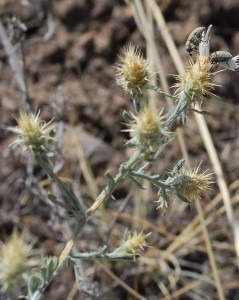
Larinus adults on knapweed. You can see adult damage on the stem.
- We hypothesised that adults and larvae of the same species feeding in different ways on the same host-plant may have similar impacts to the feeding of two separate species. Here, we test the impacts of the two feeding stages of Larinus minutus, a successful biological control agent of diffuse knapweed, Centaurea diffusa, in the southern Okanagan of British Columbia, Canada.
- At one site, observational associations between adult and larval damage were made, but no association between the damage types was found. No plant-mediated competition between the life-history stages of the beetle was shown experimentally.
- At two sites and in two years experimental manipulation of adult and/or larval feeding damage were conducted and plant performance measured. No non-independent interactions occurred but at each of the two sites a different life-history stage was responsible for reduction in the number of seeds produced by the plant.
- Although one of the two different feeding modes may be redundant at any one site, the ability of adults and larvae to reduce plant performance in different areas makes the species effective in a wider range of environments than a species with only one feeding mode.
Link to paper

